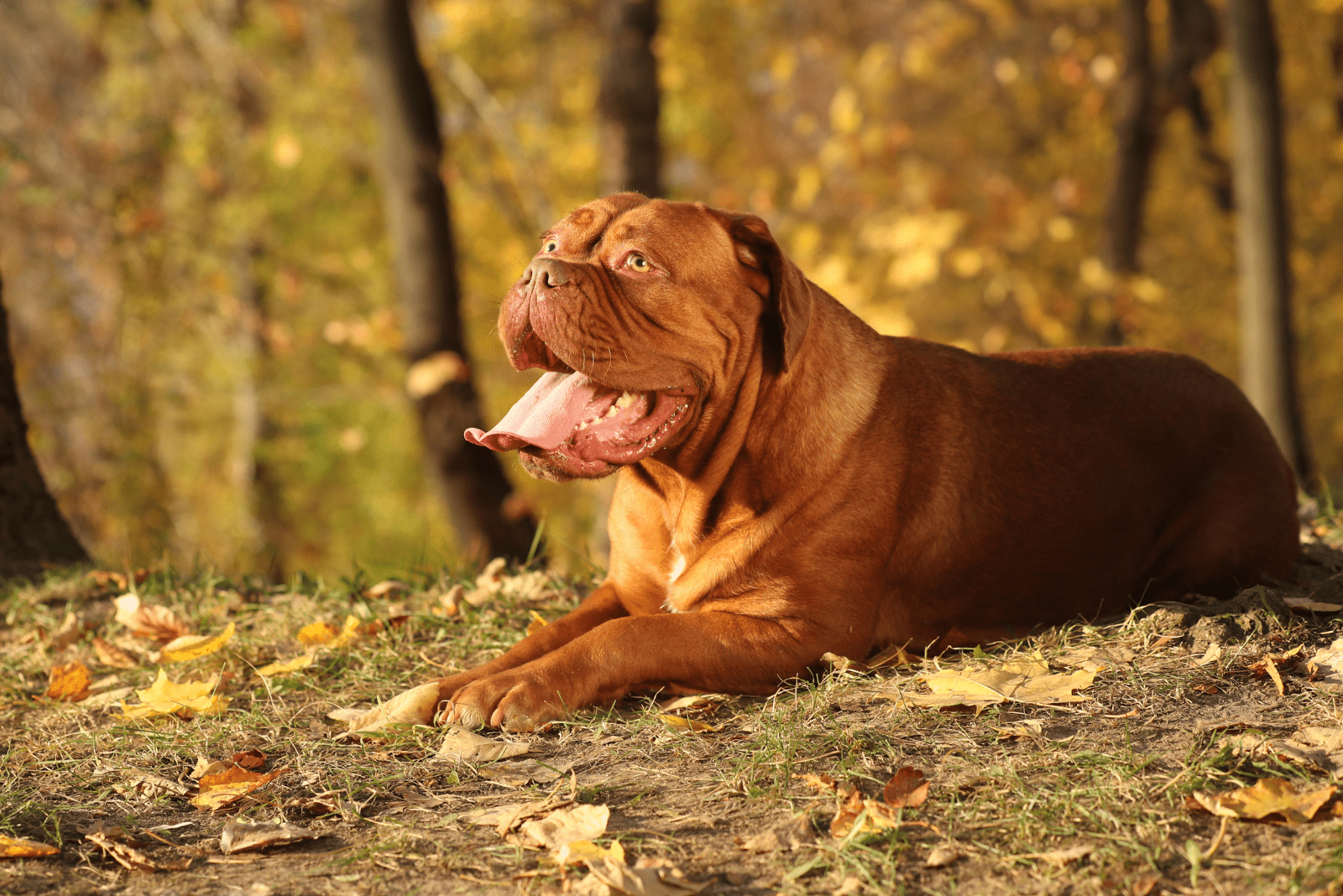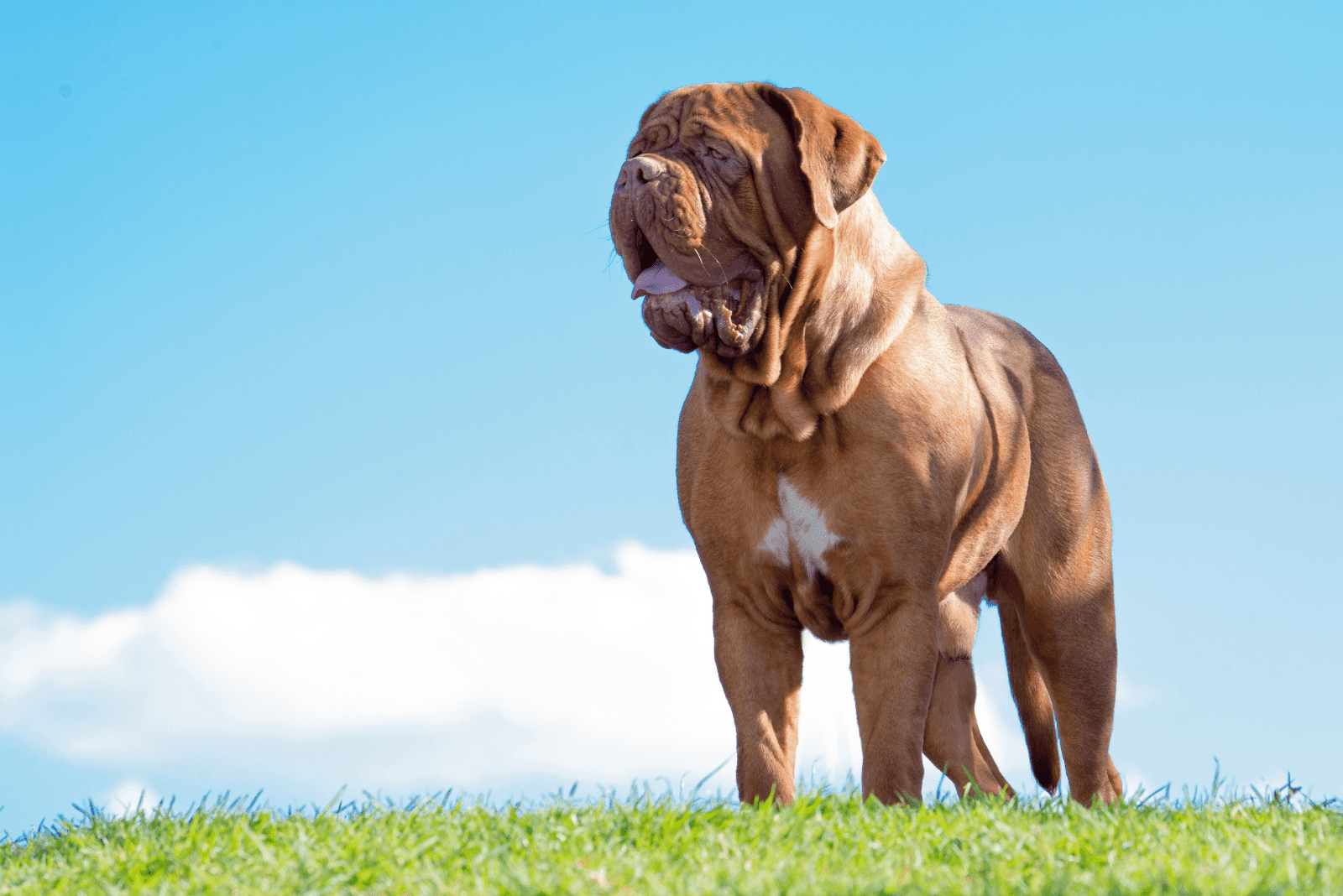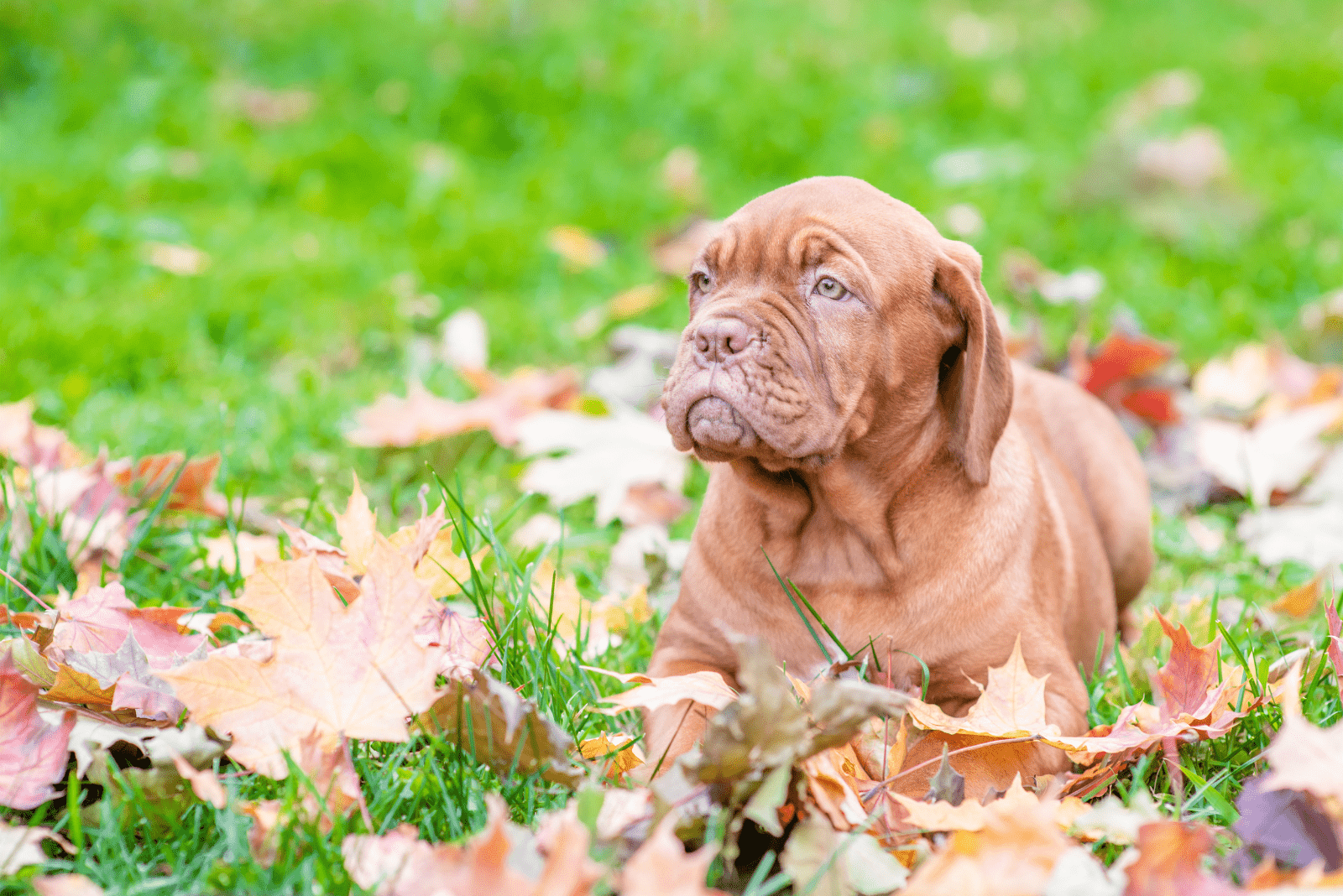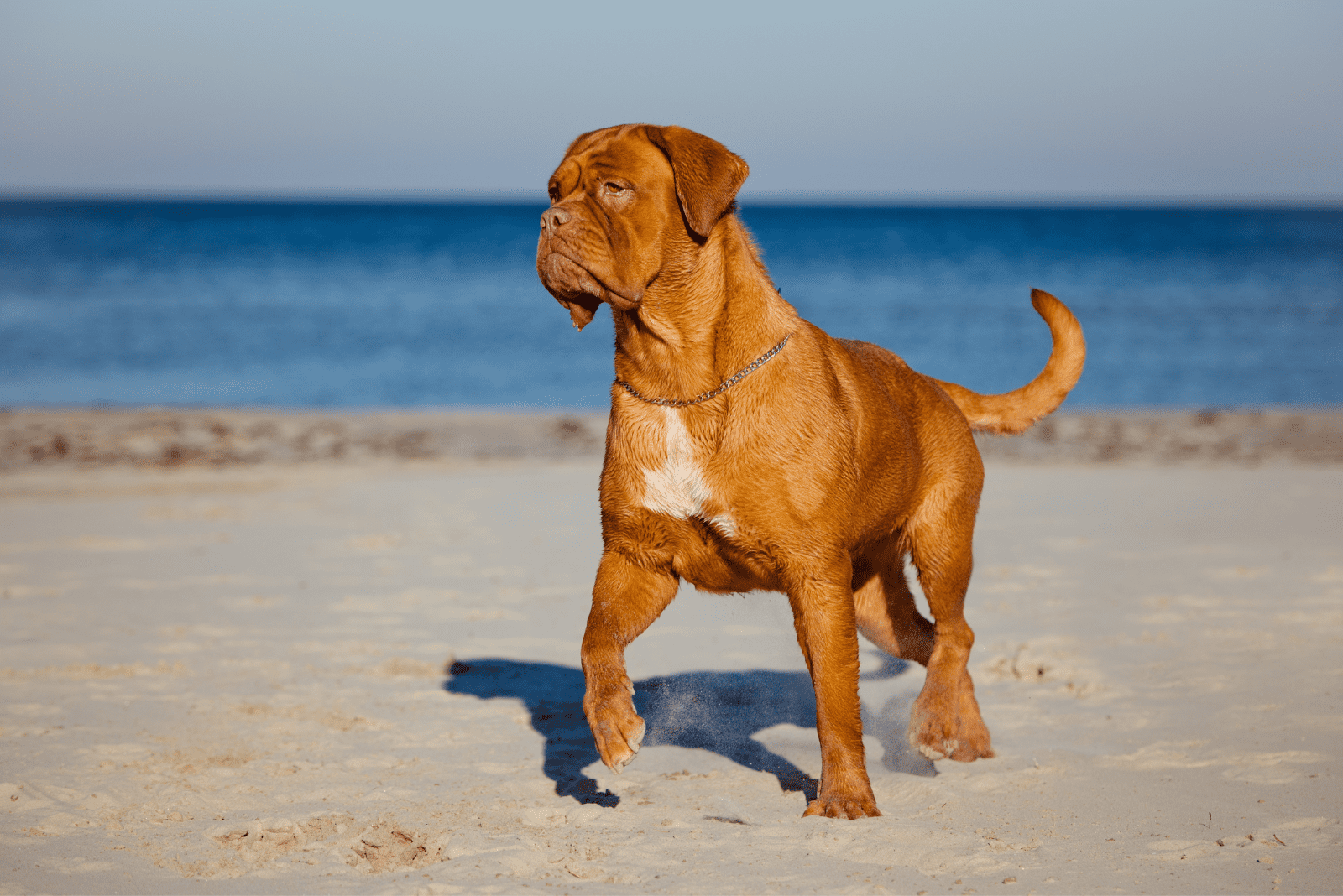The Dogue de Bordeaux, also known as the Bordeaux Mastiff or the French Mastiff, is one of the oldest French dog breeds.
Like many other dogs from the family of Mastiff breeds, these pups can get pretty big. But how big do they actually get? Well, to answer that question, we have created this Dogue de Bordeaux growth chart.
The earliest official records that we have indicate that the Dogue de Bordeaux was first bred in France as early as the 14th century, particularly in the regions surrounding the port city of Bordeaux.
However, with a breed as ancient as this one, it’s hard to pinpoint its exact origin, so it’s more likely that it has been around for far longer. These massive dogs are known for their power, bravery, and unwavering loyalty.
Those traits have made French Mastiffs continuously popular throughout the ages, and they remain a beloved pet to this day. Even though they might appear intimidating at first glance, particularly to people who are not familiar with the breed, they have a penchant for quickly getting under your skin.
Who wouldn’t love that big, drooling, Bulldog-shaped face?
One of the things that makes them so intimidating is, of course, their size. To demonstrate the growth process of these dogs, and the rate of their weight gain, we present to you the Dogue de Bordeaux growth chart.
Dogue De Bordeaux Growth Chart
[table id=609 /]
Why Do You Need A Dogue De Bordeaux Growth Chart?
There are many reasons why you should have a Dogue de Bordeaux growth chart. First of all, if you know how big your Dogue is supposed to be at certain ages, then you can cross-reference that with its actual size and weight and make sure that its development is on the right track.
If your puppy is not reaching the sizes it should, that could be a sign of health issues or bad habits when it comes to feeding and exercising. On the other hand, if the puppy is exceeding the recommended weight limits, that means that you should probably put it on a stricter diet.
But other than that, knowing the expected size of your French Mastiff can do wonders for your long-term planning. As soon as you get the puppy, you can already look into the future and see how big of a crate, bed, dog house, collar, and leash you should buy.
Additionally, you can estimate its food intake through the various stages of its life, so you can plan your budget accordingly. Dogues de Bordeaux are huge canines, and they eat a lot of dog food, but knowing the amount in advance will help you set aside the money so that you don’t have to worry later on.
Dogue De Bordeaux Growth Through The Stages Of Development
You’ve seen the chart and you know how to use it. But the numbers in the puppy weight chart are just averages and they don’t really tell you much about the pup’s actual process of development.
If you would like to know more about it than just the growth rate, then this next section is perfect for you. We have divided the development process into several stages and dissected every one of them individually.
What exactly happens to the French Mastiff’s body at two weeks of age? How does their diet change in the first couple of months? When do they reach full physical maturity?
Those are just some of the questions that we answer in this segment.
From Birth To Two Weeks Old
Adult Bordeauxs are big and imposing, but when they are first born, they are just fragile little babies who can’t do anything without the help of their mama.
They are typically born in litters of 5 to 8, with each puppy weighing around 1 pound (0.45 kg). They are extremely sensitive and vulnerable, depending on their mother for nourishment, warmth, and comfort.
Their eyes are still completely shut, and their muscles haven’t even started properly developing, so they are basically just furry sacks of meat at this point. They spend most of their time either sleeping or nursing.
They don’t need a lot of your attention during this stage, but you should keep a close eye on them anyway.
From Three Weeks To Three Months Old
This period is absolutely crucial for a Bordeaux’s development. The puppies experience a lot of new stuff during this time and really start soaking in the world around them for the first time.
Perhaps the biggest novelty for these boys and girls is the introduction of solid puppy food. At the start of this period, they will begin the process of weaning off their mommy’s milk and eating for themselves.
However, you need to keep in mind that you can’t just give them any old bag of dog food. Their teeth and gums are still in the middle of forming, and they can’t really chew through food that is too hard, too big, or too hot.
You need to make sure that you prepare the food in a way that makes it easily palatable for them or buy puppy food that is specialized for pups their age. You can even feed them raw food, but in that case, you need to know the right amounts.
It’s always a good idea to consult the vet and ask for their expert opinion, as they will probably know your dog’s situation better than anyone.
This switch to solid food will leave a big mark on puppy growth, as they will nearly double in size during this period. By the end of the third month, your French Mastiff should be approaching 40 pounds of body weight.
Another big part of this development stage is their first attempts at socialization with the humans around them, as well as other animals that might be in their surroundings.
From Four Months To One Year Old
This eight-month period is jam-packed with developmental milestones for the young Dogues de Bordeaux.
Their teeth and gums develop to a point where they can eat most solid foods, regardless of size or texture. This lets them eat bigger amounts of food, which leads to great physical growth and maturing.
Their bones and muscles go through a lot of changes and their overall frame now fully resembles the adult French Mastiff that we know and love. The actual size still isn’t quite at its peak, but you can see the progress.
They will have reached half of their full adult weight in the middle of this stage of development, and by the time their first birthday comes around, they should be crossing the 100-pound mark.
Another important thing that happens during this period, typically around six months of age, is sexual maturation. Female Bordeauxs will experience their first heat cycle around this time, which means that you, as the dog owner, will have to make the decision to spay or not to spay.
From One Year To Two Years Old
After one year of age, most of a French Mastiff’s key development points have been reached. The period from twelve months to twenty-four months of age is marked by something that we can call “rounding out” of their frame.
They are still putting on some weight and growing a bit of muscle, but that is only to fill out their frame and finally reach that muscular, square physical peak that they are known for. Generally, they will arrive at that peak between a year and a half to two years of age.
Adult Dogue De Bordeaux
A fully mature, adult Dogue de Bordeaux is truly a sight to behold. A tall, muscular, proud canine that looks imposing simply by being there.
They typically reach a height of 23 to 27 inches (58.4 to 68.6 cm) at the withers and a weight of 120 to 140 lbs (54.4 to 63.5 kg). This is the French Mastiff’s final form, and it looks so far removed from the gentle, fragile puppy that it once was.
What Impacts The Size Of A Dogue De Bordeaux?

The average weight of an adult Dogue de Bordeaux is between 120 and 140 pounds. That in itself is a pretty wide range, but there are many different factors that affect it.
Some of these factors are internal, meaning that the Bordeauxs are born with them and there isn’t much you can do about them. On the other hand, there are external factors, which you can control to a greater extent, and you should do everything that you possibly can to allow your Bordeaux to reach a healthy size and weight.
Let’s take a deeper look into these factors, both internal and external, and explain how exactly they impact the growth of a Dogue de Bordeaux.
Internal Factors
Internal factors are something that the Dogue de Bordeaux is generally born with. It can be something that it inherited from its parents or maybe a congenital medical condition that impacts its growth in a certain way.
These factors are mostly out of your control but learning about them in advance can at least help you prepare for them and know what to expect.
Genetics
Genetics play a big role in determining the size of a Dogue de Bordeaux. In the simplest of terms, if the parents were larger than average, chances are that the puppy will be, as well.
If you are getting your Dogue de Bordeaux puppy from a breeder, then you can ask them about the size of the parents so that you can get an idea of what to expect once the puppy reaches adulthood.
Read Also: 7 Best Dogue De Bordeaux Breeders In The U.S.
Gender
Typically, male Dogues de Bordeaux will be taller and heavier than their female counterparts. An adult male will average around 130 pounds (sometimes going up to 145), while an average female will be around 120 pounds.
External Factors
External factors are probably more important to know for you as the pet owner. These are something that you can influence and should take control over.
After all, it is up to you to provide your pup with all the conditions that it needs for a healthy growth and development process.
The two main elements that keep dog weight in check are proper nutrition and plenty of exercise.
Nutrition
Needless to say, a good diet can do wonders for a pup’s development. Dogues de Bordeaux should be fed nothing but the highest-quality food that is appropriate for their breed and their age. And since they are such big dogs, they will need a lot of it.
When talking about the distinct stages of development, we mentioned how you should prepare the puppy food in a certain way when you are just weaning the puppy off its mother’s milk. That is just one of the ways that you can adapt the diet to the age of the dog.
Obviously, an adult French Mastiff will not eat the same stuff, nor the same amounts, that a two-month-old puppy will. Careful diet management will go a long way in maintaining a healthy weight in your Dogue de Bordeaux.
Exercise
If nutrition is the yin, then exercise is the yang. They always go hand in hand, and one needs to be in sync with the other.
Dogues de Bordeaux are massive dogs, but surprisingly, they don’t need a huge amount of exercise, at least in comparison to other large breeds. They have a great metabolism that helps them stay in shape.
However, that doesn’t mean that you should just leave them to their own devices. They still need most of the things that all dogs do, like regular walks and playtime. It just means that you don’t have to sign them up for marathons or agility competitions every month.
Regular daily walks at a decent pace should provide enough physical stimulation for them to stay fit.
Frequently Asked Questions

Now that we have covered all the most important facts related to Dogue de Bordeaux growth, it’s time to move on to frequently asked questions.
Whether you already own a Bordeaux or you’re looking to adopt one soon, these questions must have crossed your mind at some point. Having a Dogue de Bordeaux growth chart is great, but sometimes you just need a specific question answered.
Well, that’s exactly what this section is for. We’ve searched the internet for the most common issues and doubts related to French Mastiff size and collected them all here.
How Big Will My Dogue De Bordeaux Get?
When fully grown, male Dogues de Bordeaux are 23 to 27 inches tall and weigh around 120 to 145 pounds. Females, on the other hand, will typically have a similar height range but weigh a little less — around 120 to 130 pounds.
When Will My Dogue De Bordeaux Stop Growing?
French Mastiffs generally arrive at their physical peak between the ages of 18 and 24 months. In most cases, they stop growing around the time they are 19 months old.
Of course, there are exceptions, as every dog grows at its individual rate.
After this time, they can still continue to add weight, but it will most likely not be muscle weight. All the pounds that they add will probably be undesirable and you should take special care of their diet and exercise to ensure they stay within the healthy weight range.
Obesity is not as common with large dogs as it is with small dogs, but it can sometimes affect them more harshly, due to the pressure that such large weights can put on the bones and joints.
Does Spaying/Neutering Affect Dogue De Bordeaux’s Growth?
If you want the short answer, then… yes. But in reality, it’s not that simple.
For example, neutering a male French Mastiff too early can mess up his hormone levels. Hormones are a key part of puppy development and if they’re out of whack, growth could be disrupted.
Of course, there are also many advantages to spaying and neutering. It can prevent a lot of diseases and avoid unwanted pregnancies, which are two big things.
So, with both the pros and cons in mind, the best advice that you can get is to always consult your vet when deciding whether to neuter, and always wait until the Bordeaux is sexually mature.
Do Dogues De Bordeaux Come In Different Sizes?
According to the American Kennel Club, there is only one breed-standard size of the Dogue de Bordeaux.
There are, of course, various Mastiff mixes that come in different sizes, but purebred French Mastiffs only have one adult size category.
What Are The Health Problems Related To Dogue De Bordeaux Size?
Large dogs tend to have higher risks of certain diseases, which is why they often have shorter lifespans than smaller dogs. Just look at Cane Corsos or Bullmastiffs, for example.
Dogue de Bordeaux is, sadly, one of those breeds that often struggle with health issues. That is reflected in their very short life expectancy, which is only about 5-8 years, according to the AKC.
They are at a high risk of being affected by conditions such as bloat, heart disease, and even cancer. When it comes to size and weight-related problems, they are not 100% safe there, either.
They don’t tend to struggle with obesity, but they can be underweight occasionally, particularly if they have been neutered too early.
Furthermore, their size and weight can take a toll on their skeleton, which can often lead to bone and joint problems, such as hip dysplasia, for instance.
Final Thoughts

The Dogue de Bordeaux growth chart is basically essential reading for any current or future Bordeaux owner.
It is a great tool that will help you stay on top of your pup’s height and weight and make sure that their development is on the right track and ticking all the right boxes. The best thing about it is that you can always go back to it and check your dog’s progress.
Additionally, we have provided a lot of extra information in this article to go along with the Dogue de Bordeaux growth chart in hopes that it can help you better understand all the changes that your beloved pet will go through in its various stages of development.
Read Next: Whippet Growth Chart — Is My Whippet Normal?
